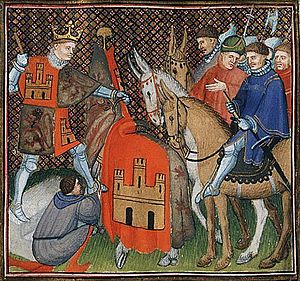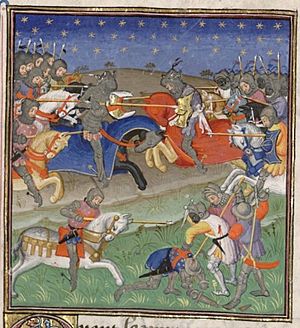Alfonso XI of Castile facts for kids
Quick facts for kids Alfonso XI |
|
|---|---|

Detail of a contemporary depiction in the Book of the Coronation of the Kings of Castile (14th century)
|
|
| King of Castile and León | |
| Reign | 7 September 1312 – 26 March 1350 |
| Predecessor | Ferdinand IV |
| Successor | Peter |
| Born | 13 August 1311 Salamanca, Kingdom of Castile |
| Died | 26 March 1350 (aged 38) Gibraltar, Emirate of Granada |
| Burial | Royal Collegiate Church of Saint Hippolytus |
| Spouse | |
| Issue among others... |
|
| House | Castilian House of Ivrea |
| Father | Ferdinand IV of Castile |
| Mother | Constance of Portugal |
| Religion | Roman Catholicism |
| Signature | |
Alfonso XI (born August 11, 1311 – died March 26, 1350) was the King of Castile and León. He was also known as the Avenger (el Justiciero). Alfonso was the son of Ferdinand IV of Castile and his wife Constance of Portugal.
Alfonso became king when he was very young. When he was declared an adult in 1325, he began to rule and made the royal power stronger. He achieved important victories, like the Battle of Río Salado against the Granadans and Marinids. He also helped Castile gain control over the important Strait of Gibraltar.
Contents
Life as King
His Early Years

Alfonso was born on August 13, 1311, in Salamanca. His father, King Ferdinand IV of Castile, died when Alfonso was only one year old. Because he was so young, several people helped rule the kingdom as his guardians. These included his grandmother, María de Molina, and his mother, Constance.
Sadly, his mother died in 1313. Later, in 1319, two other important guardians died during a military campaign against Granada. This left his grandmother, Queen María, as the main guardian until she passed away in 1321.
When Alfonso became king, the kingdom faced many challenges. There were conflicts among the nobles and problems with the royal money. A 14th-century writer described King Alfonso as "not very tall but well proportioned, and he was rather strong and had fair skin and hair."
Becoming an Adult King
Alfonso officially began his rule in August 1325. He was sworn in as king in the Cortes (a type of parliament) of Valladolid. After some important ceremonies, he crowned himself king in 1332.
Once he took the throne, Alfonso worked hard to make the king's power stronger. He did this by dealing with nobles who caused trouble. He was very firm in his decisions to bring order to the kingdom.
He was very successful in expanding his kingdom's borders. He won a major victory at the Battle of Río Salado in 1340 against the Marinid dynasty. He also conquered the Kingdom of Algeciras in 1344. After these victories, he focused his efforts on fighting the Moorish king of Granada.
During his time as king, he also made changes to how towns were governed. He encouraged the creation of new towns and helped them grow by giving them special rules called cartas pueblas.
Alfonso XI is known as "the Avenger" or "the Implacable." These names show how strongly he dealt with the problems caused by the nobles when he was young. He is also called "He of Río Salado" because of his important victory in that battle.
King Alfonso XI died during the siege of Gibraltar in 1350. He caught the Black Death, a terrible disease that spread across Europe. He passed away on the night of March 25–26, 1350. Out of respect, his rival, Yusuf I of Granada, ordered his army not to attack the Castilian forces as they carried the king's body back to Seville.
Family Life
Alfonso XI first married Constanza Manuel in 1325, but this marriage was ended two years later. In 1328, he married his cousin, Maria of Portugal. They had two children:
- Ferdinand (1332–1333)
- Peter of Castile (1334–1369), who later became King of Castile.
Alfonso also had ten children with his mistress, Eleanor of Guzmán:
- Pedro Alfonso (1330–1338)
- Sancho Alfonso (1331–1343)
- Henry II of Castile (1334–1379), who also became King of Castile
- Fadrique Alfonso (1334–1358), Henry's twin brother
- Fernando Alfonso (1336–c. 1350)
- Tello Alfonso (1337–1370)
- Juan Alfonso (1341–1359)
- Juana Alfonso (born 1342)
- Sancho Alfonso (1343–1375)
- Pedro Alfonso (1345–1359)
In Popular Culture
Alfonso XI was featured in a play called Alfonso, King of Castile. This play was written in 1802 by a British writer named Matthew Lewis. It was first performed in London.
See also
 In Spanish: Alfonso XI de Castilla para niños
In Spanish: Alfonso XI de Castilla para niños
Images for kids


